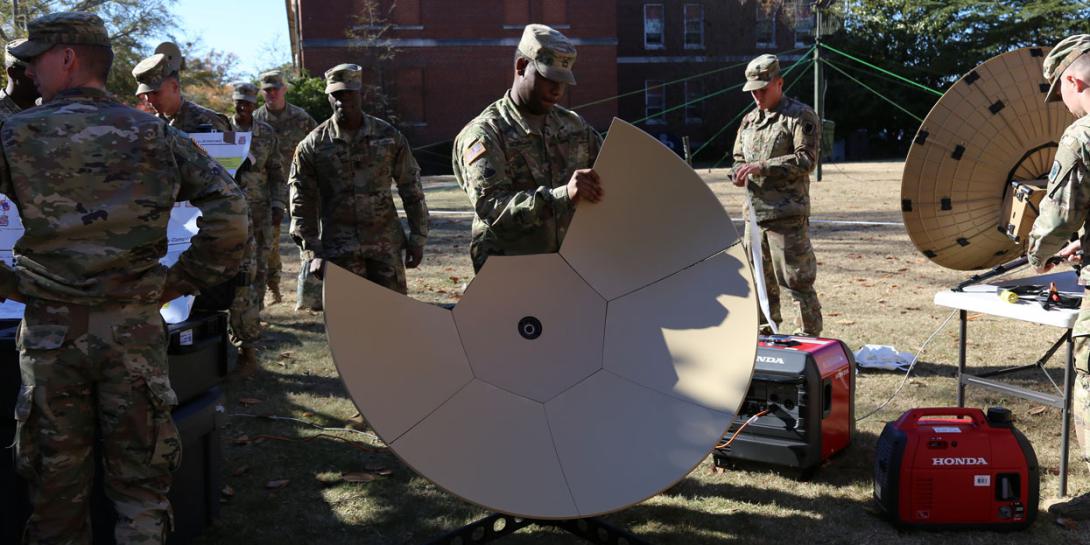Leaders Outline Plan for the Army's Integrated Tactical Network
Army leaders are tackling the integration of modern network capabilities to push out broadly across the Army force structure over the next decade.
Maj. Gen. David Bassett, USA, program executive officer for Command, Control, Communications-Tactical (PEO-C3T) and Maj. Gen. Peter Gallagher, USA, director, Network Cross-Functional Team (Network CFT) are overseeing the effort and have developed an iterative plan to bring together network transport, mission command applications and services, all easily deployed to soldiers.
“We know that the things that we are doing today are going to develop capabilities that are going to have a significant improvement in our expeditionary capability, and also in the simplicity of the network design,” Gen. Gallagher said.
“And when a unit gets it, they will know it’s all going to work together,” Gen. Bassett noted.
The leaders unveiled the direction of the Army Integrated Tactical Network, known as the ITN, at a recent AFCEA Aberdeen Chapter event.
Gen. Gallagher said he received “very direct marching orders” in December from Gen. John Murray, USA, commander of the new Army Futures Command, in regard to the plan for the tactical network. “One of Gen. Murray’s directions was that we need to either package it in increments or capabilities sets to show Army senior leadership how it will evolve over time and where industry, research and science and technology are going to fit into this network design over time,” Gen. Gallagher shared.
The plan includes four lines of effort, with a move in 2019 to a “capability package construct” that will support the fielding of capabilities over a two-year iterative process, beginning in fiscal year 2021, said Paul Mehney, director, Public Communications, PEO-C3T.
According to Gen. Gallagher, of the four lines of effort, the number one priority is preparing a unified network. “It’s our network transport, which is really about assured network transport in a contested environment against a peer adversary so we can fight and win anywhere the Army needs to go,” he stated. As part of that venture, the Network CFT and PEO-C3T held their first technology exchange with the industry in February 2018, which helped define “where we need to go with the network, in order to dominate in a cyber and electromagnetic activities environment,” Gen. Gallagher said.
The second priority is the common operating environment. “It’s the Command Post Computing Environment, our mounted and dismounted computing environments, all of our decision-making tools to support the rapid decision making of leaders and soldiers, faster than our adversaries,” he noted.
Third, the Network CFT and PEO-C3T are pursuing joint and coalition interoperability, “most of which includes policy, encryption standards, classification boundaries, and how we share with joint teammates and coalition and allied partners,” Gen. Gallagher said. “If we do Line of Effort 1 and 2 right, we are getting after Line of Effort 3.”
Fourth is the mobility and survivability of the Army’s Command Post. “In a very lethal fight against peer adversaries, we can anticipate that our formations are going to have to get out of the forward operating base and be able to move rapidly, to ensure we a distributed mission command,” he stated. “That is what we are striving for by 2028.”
During the rest of this fiscal year, the Army is moving ITN capabilities out of the Science and Technology phase and into important testing, and in 2020, conducting integration and testing.
The first major milestone is Capability Set 2021, or CapSet21, which includes communication capabilities that are smaller, lighter and faster; easy to use applications and devices; and multiple options for connectivity with improved network security and management systems, according to PEO-C3T.
CapSet 21 will initially equip four infantry brigade combat teams through several ongoing pilot programs. The effort is aimed at improving the capabilities of expeditionary signal battalions and as well as fighting forces for brigade and below, Gen. Gallagher said. The related technology will be purchased with funds from FY 2019 and 2020.
“I don’t want you to think that we are going to wait two years to put advanced capabilities into the hands of soldiers,” Gen. Bassett clarified. “That is not what we are saying. The experimentation and putting capabilities into units, getting feedback from those units, all of that is ongoing. But what 2021 gives us is a unifying construct, so that we can show that as we deliver capability, it is integrated together, and represents the best technology available at the timeframe.”
In addition, the Army is laying the groundwork for CapSet23, which is focusing on a significant increase in capacity and resilience in the network, with capabilities such as high capacity commercial satellite communications (SATCOM), protected SATCOM waveforms, low-Earth orbit (LEO) constellations, and Internet in space. The capabilities will provide increased bandwidth and mobility for maneuvering, as well as initial cloud and anti-jamming technology.
“It is about multipath connectivity, giving our leaders and commanders out there and soldiers on the edge, not only a simpler network and an expeditionary network, but also options when in adversarial environments,” Gen. Gallagher stated.
By 2025, the Army’s ITN will be more automated and protected, with full cloud capability, automated network management and decision-making tools, 5G or equivalent connectivity, advanced air-ground communications and network security, and combat and tactical vehicle mobile command posts, the PEO-C3T reported.
And by 2027, the Army’s ITN will support “multidomain dominance” through capabilities such as hardened wireless connectivity, artificial intelligence, machine learning, a common operating environment with common applications across formations and a reduced electromagnetic signature.





Comment
Great article!! caught all
Great article!! caught all the details.
Comments